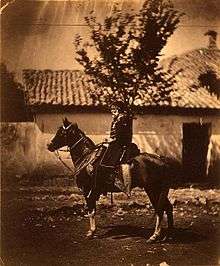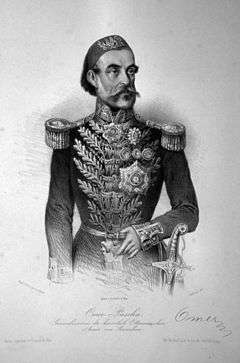Omar Pasha
| Omar Pasha Serdar-ı Ekrem Ömer Paşa | |
|---|---|
|
A portrait of Omar Pasha by Adolf Dauthage | |
| Birth name | Mihajlo Latas / Михајло Латас |
| Born |
1806 Janja Gora near Plaški, Military Frontier, Austrian Empire |
| Died |
1871 Constantinople, Ottoman Empire |
| Allegiance |
|
| Service/branch |
|
| Years of service | 1823-1869 |
| Rank | Field marshal |
| Commands held | Commander of Ottoman Forces in Moldavia & Wallachia |
| Battles/wars |
Albanian Revolt of 1843–1844
|
| Spouse(s) |
Ida Hanım (divorced without issue) Adviye Hanım (with issues) |
Omar Pasha Latas (Turkish: Ömer Paşa, Serbian: Омер-паша Латас/Omer-paša Latas; 1806–1871) was an Ottoman field marshal and governor. He was born in Austrian territory, to Serbian Orthodox Christian parents, and was initially an Austrian soldier. When faced with charges of embezzlement, he fled to Ottoman Bosnia and converted to Islam, and then joined the Ottoman army where he quickly climbed in ranks. Latas crushed several rebellions throughout the Empire, and was a commander in the Crimean War, where he won some outstanding victories at Silistra and Eupatoria and participated in the siege of Sevastopol.
Early life
Omar Pasha was born Mihajlo Latas (Serbian: Михајло Латас), an ethnic Serb and Orthodox Christian,[1][2] in Janja Gora, at the time part of the Croatian Military Frontier of the Austrian Empire (in modern Plaški, Lika region, Croatia).[1][3]
His father Petar served in the Austrian Army and in time was appointed lieutenant-governor of the Ogulin district.[4] His uncle was an Orthodox priest.[5] Mihajlo was an intelligent and lively child, if rather sickly. He developed a passion for the military, and on leaving school in Gospić, he went to a military school in Zadar and was accepted as a cadet in his father's Ogulin Regiment on the frontier. He had beautiful handwriting, and was assigned to clerical duties. There he might have languished, if his father had not upset someone along the corruption line and suffered a conviction for misappropriation. Mihajlo escaped charges of embezzlement, having stolen 180 florins from the military safe, by fleeing to the Ottoman Bosnia Eyalet in 1823.[6]
Military career

After escaping to Bosnia and living rough for a time, Latas was offered a position as tutor to the children of a Turkish merchant, on condition that he converted from Christianity to Islam and was circumcised. After his conversion he took the new name Omar. A necessary condition to fulfill in order to get off the streets, it was a huge cultural step that led naturally to his decision that his future lay with the Ottomans. The big break came for the newly named Omar when the family moved to Constantinople. By astute networking and doubtless exploiting his curiosity value as an ex-European military man, he was appointed lecturer at the Turkish Military Academy. With this exposure he shone enough to be snapped up as aide-de-camp to the Polish–Ottoman General Wojciech Chrzanowski, who was engaged in the re-organization of the Ottoman Army after the defeat of the Janissaries.[7]
Now a major, Omar completed a mapping assignment in Bulgaria and the Danube territories, gaining detailed knowledge of the ground which was to serve him well in the future. Chrzanowski also milked his ideas for re-organizing the Army; in return he smoothed the way for Omar's introduction into Turkish society. He thereby met and married a rich heiress Adviye Hanım (daughter of Çerkes Hafız Pasha), the start of his meteoric rise in Ottoman military circles. There is no doubt that Omar's marriage opened all the right doors for him,[7] but equally no doubt that he proved equal to the challenges of high command which resulted. He became writing-master to the Ottoman heir, Abd-ul-Medjid, and on the succession of the latter in 1839 was made a colonel. He was shortly afterwards appointed Military Governor of Constantinople. His only daughter, Saffet Hanım, married Mustafa Celalettin Pasha.

In 1840-41 he led a successful expedition to quell a revolt in Syria, and in 1842 was Governor of the Tripoli Eyalet (Lebanon).[7] He won distinction in suppressing the Albanian Revolt of 1843–44, led by local Muslim aristocrats. There followed the expedition to Kurdistan following the Massacres of Badr Khan (1846).[7] After the Hungarian Revolution of 1848, Omar Pasha was put in command of the Ottoman forces in Moldavia and Wallachia. His firm and effective handling of a powder keg situation involving potential confrontation with the Russian and Austrian armies demonstrated that he possessed considerable diplomatic skills.[8] There followed his command in Bosnia (1850) where he executed Ali-paša Rizvanbegović of Stolac, who had defended Ottoman power during an earlier revolt but then started to build up an independent power base.[9] Omar Pasha executed, plundered and abolished the respected historical aristocracy of Muslim faith, in the interest of buttressing Ottoman central power.[10] This was followed by a command in the Principality of Montenegro (1852). His chief services were rendered when the Crimean War broke out.[11] In 1853 he successfully defended Kalafat. In 1854 he entered Bucharest, and the next year defeated 40,000 Russians at Eupatoria in the Crimea. A later achievement was his capture of Cetinje, Montenegro, during the Montenegrin–Ottoman War (1861–62), considered a difficult feat.
A clear and precise military thinker, Omar Pasha took bold decisions and relentlessly followed them through. Although he had a reputation as a strict and ruthless disciplinarian, he was revered and respected by his men. A true professional, while the other allies struggled to come to grips with local campaigning conditions, he had seen it all too often before.[12] Perhaps for that reason the allied troops found his expression cold and uninterested when seated on his horse plodding round their lines.
Timeline
- Tutor in the household of Hussein Pasha, Governor of Widdin.
- 1834 - Writing master in a military school at Constantinople.
- Instructor to Abd ul Medjid, heir apparent to the throne.
- 1842 - Appointed Governor of Lebanon.[13]
- 1843 - Repressed insurrection in Albania.
- 1846 - Repressed insurrection in Kurdistan.
- 1850 - executed Ali-paša Rizvanbegović of Stolac, plundered and abolished the respected historical aristocracy of the Bosniaks.
- 1852 - defeated the Montenegrins under Prince Danilo
- 1853 - Defeated the Russians at Olteniţa.
- 1854 - Successfully defended Silistria against Russians, gaining possession of Bucharest.[14]
- 1855 - Repulsed the Russians at Eupatoria, Crimea and captured Sukhumi in Caucasus.
- 1857-59 - Governor of Baghdad.
- 1862 - Defeated Montenegrin army and took possession of Cetinje.
- 1864 - Made field marshal.
- 1867 - Fought rebels in Crete.
- 1869 - Made Minister of war.
References
- 1 2 Ćirković 2004, p. 222.
- ↑ Andrew James McGregor (2006). A Military History of Modern Egypt: From the Ottoman Conquest to the Ramadan War. Greenwood Publishing Group. p. 121. ISBN 978-0-275-98601-8.
- ↑ Barbara Jelavich (1983). History of the Balkans:. Cambridge University Press. p. 349. ISBN 978-0-521-27458-6.
- ↑ Bessé & Morris 1855, p. 23.
- ↑ George Julian Harney (1853). The Vanguard. J. P. Crantz. p. 40.
- ↑ Georg Martin Thomas (1883). August von Jochmus' gesammelte Schriften, herausg. von G.M. Thomas.
- 1 2 3 4 de Bessé, Morris, p. 25
- ↑ James, p. 121-122
- ↑ de Bessé, Morris, p. 26
- ↑ Chambler's, p. 707
- ↑ Goldstein, p. 24
- ↑ de Bessé, Morris, p. 26-27
- ↑ Churchill, p. 63
- ↑ Murdock,Fiske , pages 36-40
Sources
| Wikimedia Commons has media related to Omar Pasha. |
| Wikisource has the text of the 1905 New International Encyclopedia article Omer Pasha. |
- Muradbegović, Ahmed (1944). "Omer-paša Latas u Bosni, 1850-1852". 42. Matica hrvatska.
- Laurence Oliphant (1856). The Trans-Caucasian campaign of the Turkish army under Omer Pasha: a personal narrative. W. Blackwood and sons.
- Bessé, Alfred; Morris, Edward Joy (1855). The Turkish empire, embracing the religion, manners and customs of the people, with a memoir of the reigning sultan and Omer Pacha. s.n.
- Sweetman, John (2001). The Crimean War: 1854-1856. Osprey Publishing. ISBN 9781841761862.
- The Ottman Empire and Its Successors, 1801 -1927. CUP Archive.
- Ćirković, Sima M. (2004). The Serbs. Wiley-Blackwell. p. 222. ISBN 0-631-20471-7.
- Chambers's biographical dictionary: the great of all times and nations by David Patrick, Francis Hindes Groome; W. & R. Chambers, limited, 1907 page 706
- The Near East in Modern Times: The Ottoman Empire and the Balkan States to 1900, by G. G. Arnakis, Wayne S. Vucinich; Pemberton Press, 1969 pages 207, 345
- Wars and Peace Treaties, 1816-1991 by Erik Goldstein; Routledge, 1992 page 24
- The encyclopedia of nineteenth-century land warfare: an illustrated world view by Byron Farwell; W. W. Norton & Company, 2001 page 613
- The Balkan Economies C. 1800-1914: Evolution Without Development by Michael R. Palairet; Contributors: Charles Feinstein, Patrick O'Brien, Barry Supple, Peter Temin, Gianni Toniolo; Cambridge University Press, 2004 page 133
- Religious separation and political intolerance in Bosnia-Herzegovina by Mitja Velikonja; Texas A&M University Press, 2003 pages 85–86
- History of the Balkans: Eighteenth and nineteenth centuries by Barbara Jelavich; Cambridge University Press, 1983 page 345
- An Ethnohistorical Dictionary of the Russian and Soviet Empires by James S. Olson, Lee Brigance Pappas, and Nicholas C.J. Pappas; Greenwood Press (March 30, 1994) page 8
- The Druzes And The Maronites Under The Turkish Rule From 1840 To 1860 by Charles Henry Churchill; Kessinger Publishing (June 30, 2004) pages 64, 72-74,77-79
- A military history of modern Egypt: from the Ottoman Conquest to the Ramadan War by Andrew James; Greenwood Publishing Group, 2006 p121-122
- The Turkish Empire; Its Historical, Statistical, and Religious Condition: Also Its Manners, Customs, Etc. by Alfred de Bessé, Edward Joy Morris, Contributors: John Fagan and Thomas S. Sinclair; Lindsay & Blakiston, 1854 pages 24–27
- The Reconstruction of Europe: A Sketch of the Diplomatic and Military History of Continental Europe, from the Rise to the Fall of the Second French Empire by Harold Murdock, John Fiske; Houghton, Mifflin and Company, 1889
